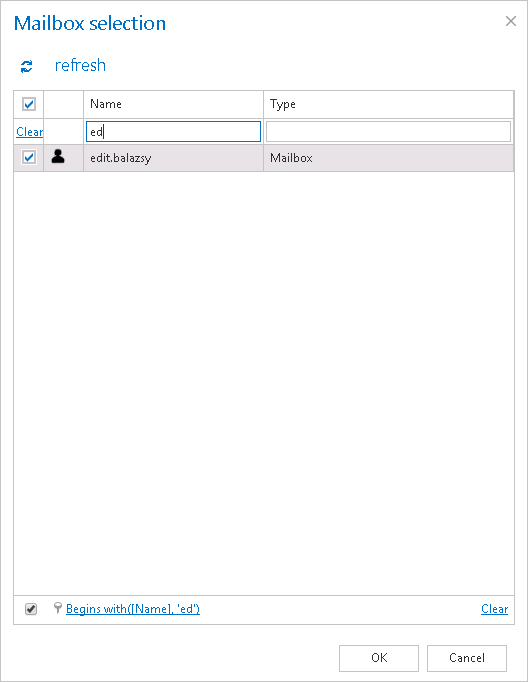12.17.1.Email archive job configuration
In this use case, we will configure an email archive job, which will archive the mailbox items of mailbox “edit.balazsy@tech-arrow.com” that are older than 1 year, but younger than 2 years. The archived items will be replaced by HTML shortcuts. The archiving process will run each working day from 5 PM CET till midnight. For this processing type, it is a must to configure the following sections on the job’s configuration page:
✓ Report mode settings:
If the Use report mode checkbox is checked, the job will run in report mode. After the job finishes its run in this mode, the user will be able to download a .csv report file here in this section. The file will contain a list of emails that belong to the entities selected in section Address book objects to process of the job and some information about them, including whether they will be processed or not.

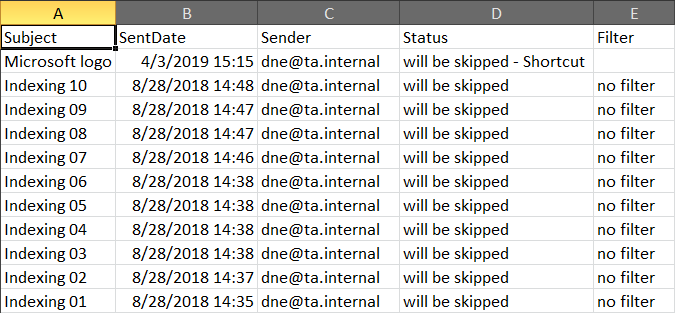
✓ Processing settings:
From the Archive dropdown list, the administrator has to choose what will be archived by the Archiving job. There are 3 options:
- Mailboxes
- In-Place Archives
- Mailboxes and In-Place Archives
The administrator may select here if he would like to use the MAPI protocol to communicate with the Exchange server. EWS (Exchange Web Services) connection is selected by default if MAPI is not selected here. It is important to know, that O365 Exchange server does not support MAPI connection. Another requirement to use MAPI is to have an Exchange server 2013 or earlier version.
The Use journal archive to build folder structures of mailboxes option will allow the job to update the folder IDs and create the correct folder structure. The job goes through a mailbox, searches for the email in the archive, and updates its folder ID (creates also the folder in the archive if it hasn’t existed yet). Read more about journal processing here.
If you check the Archive email if journal didn’t archive it yet sub-option, the archive job will also archive the email if it was not yet archived using the journal processing. Read more about journal processing here.


If this option was checked, but the email was containing an embedded email (.msg attachment), this embedded email won’t be displayed among the attachments in our apps.
✓ Database settings:
Select an already configured connection from the dropdown list. Here the metadata will be stored. We have configured for our archived emails the database named “Email Archive DB”, so we set it here. (For further information on how to set database connections please refer to section Databases.)

In this step, the running time(s) of the Email archive job must be selected. It is possible either to select a scheduler from the list or to create a new scheduler via create new… option from the dropdown list. For an email archive job, it is recommended to set a Week schedule with a repeat, which will start the job at the same time every day. In our use case, we set a scheduler that starts the archive job every day after business hours (starts at 5 PM CET and ends at midnight). (For more information about how to set schedulers refer to the section Schedules above.)

Choose an already configured storage from the dropdown list. The processed binaries will be stored here. On the screenshot below we selected our already configured disk type store: “Email Archive store”). (For more information on how to set storage check section Storages above.)

In this section, the user configures what will be archived and how it will be archived. It is also possible to delete emails that are already archived. There are three options to select in the Shortcutting section:
- 1. Apply to NOT ARCHIVED items – in the mailbox, the emails will be replaced by the shortcut that is set in the “Apply to NOT ARCHIVED items” section. You can use any previously configured shortcut type that was configured in section Shortcut configuration above. If the mailbox items have not been archived yet (are archived for the 1st time), check the “Apply to NOT ARCHIVED items” checkbox. It is recommended to use an HTML shortcut for emails/attachments that are 1 to 2 years old. The user can set which emails will be archived with the filtering setting by clicking on the “not set” or “Change filter” buttons.

- 2. Apply to ALREADY ARCHIVED items with keep original shortcutting method – if the items are already archived (e.g. with the “Keep original” method), but they need to be replaced with shortcuts, check the second checkbox and specify a previously configured shortcut type that should be used. It should be mentioned that these 2 processes will always run in 2 stages (even if both processes are configured within one job). By the 1st run of the job the items will be archived, by the 2nd run of the job the (archived) items will be replaced by the selected shortcuts. If an email has been shortcutted before but was then restored or recovered, the “Apply to ALREADY ARCHIVED items with keep original shortcutting method” checkbox must be checked if the user wants the email to be processed by the job. The user can set which emails will be replaced with shortcuts with the filtering settings by clicking on the “not set” or “Change filter” buttons.

- 3. Delete items from Exchange mailboxes which are ALREADY ARCHIVED – this option allows the user to delete already archived items from the original mailboxes. The delete function handles the orphan shortcuts (which were already deleted from the archive but still exist in the mailbox) too. On the other hand, foreign/unknown shortcuts (emails which are not found in the archive) are skipped and not deleted. The user can set which emails will be deleted from the mailbox with the filtering settings by clicking on the “not set” or “Change filter” buttons.

Click on the Change filter or not set buttons and set the filtering according to your needs and/or regulations. To learn more about how to work with filtering settings, please, check this section of our documentation.
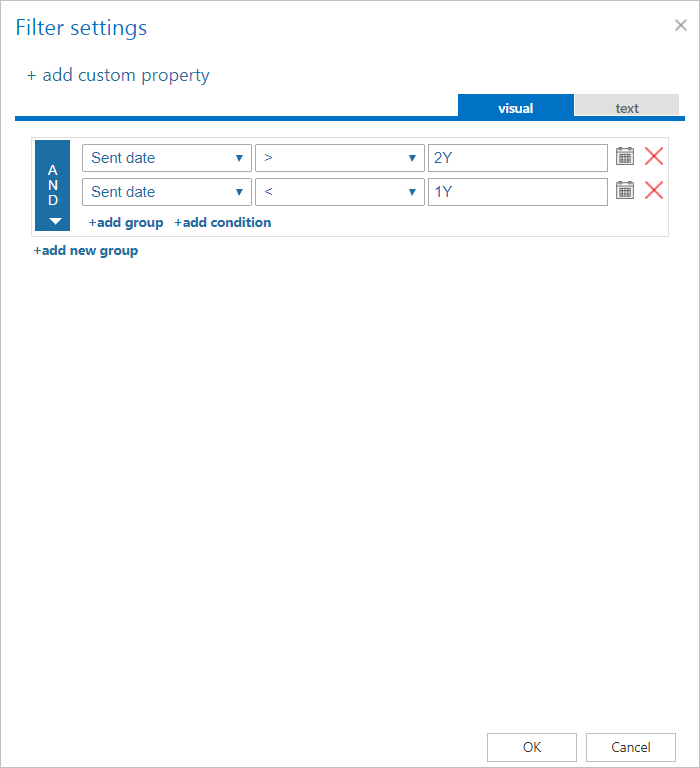
Use case: archive emails older than 1 year
In this use case, we would like to archive emails older than 1 year and replace them with a shortcut. We are configuring the option “Apply to NOT ARCHIVED items” only.

The emails will be archived and immediately replaced by a shortcut.
Use case: archive immediately, create shortcut later
In this use case, we will configure the archiving job to archive all emails (regardless of age) with the shortcut type Keep original. This will ensure that all emails are archived, but the mailbox is kept intact. Emails older than 3 months will be further processed – after these are archived, they will be converted to HTML shortcuts.


✓ Retention settings:
Choose an already configured retention time from the dropdown list. The archived emails will be stored during this time in the storage, and it will be impossible to delete them from there. It is highly recommended to select a retention time that is required by the law of your country. (For more information about how to set retentions check section Retentions above.)

Here the administrator may select the mailboxes, groups or the entire Exchange server, which will be processed by the archive job. Click on the
 select option and check the desired groups or servers in the Mailbox selection window, then click on OK.
select option and check the desired groups or servers in the Mailbox selection window, then click on OK.

In this use case, we will archive mailbox “edit.balazsy@tech-arrow.com”, so we select it from the list:
Steps to take:
- open job’s configuration page
- remove the group from the list of Address book objects to process
- select the group and re-add it to the list
- save the job configuration
✓ Include folders:
The email archive job is crawling the entire mailbox or recursive folder structures from the mailbox for further processing. Before you enter the folder name(s) to be crawled, it is necessary to select the folder filtering type.

Since the backslash “is used as a path separator, it can’t be used in the folder name. If you want to include or exclude a folder that contains a backslash in its name, enter it with “_|_” instead of ““.
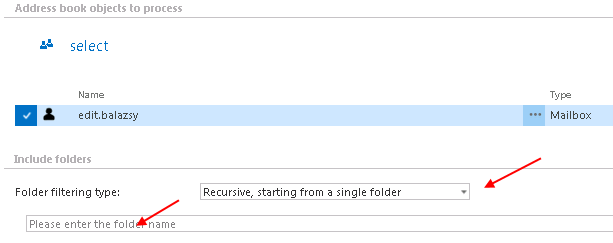
In our use case, we select the whole “INBOX” to archive:

With this function, you may set which folders/subfolders should not be archived. If you would not like to exclude any folder from the archive process, you can skip these settings.
The folders may be excluded using one of the available methods: a) They may be added manually via the + new option; b) they may be imported in one of the available file formats via the import option.
Since the backslash ““ is used as path separator, it can’t be used in folder name. If you want to include or exclude a folder which contains backslash in its name, enter it with “_|_” instead of ““.
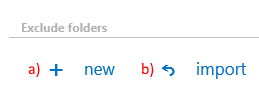
- Add exclude folders manually:
Click on + new option. In the Exclude folder dialog’s textbox specify the folder(s) to be excluded. Use the hints that are featured in the same dialog. %INBOX%TECH-ARROW pattern on the picture below means that “TECH-ARROW” folder on the “INBOX” root folder will be excluded.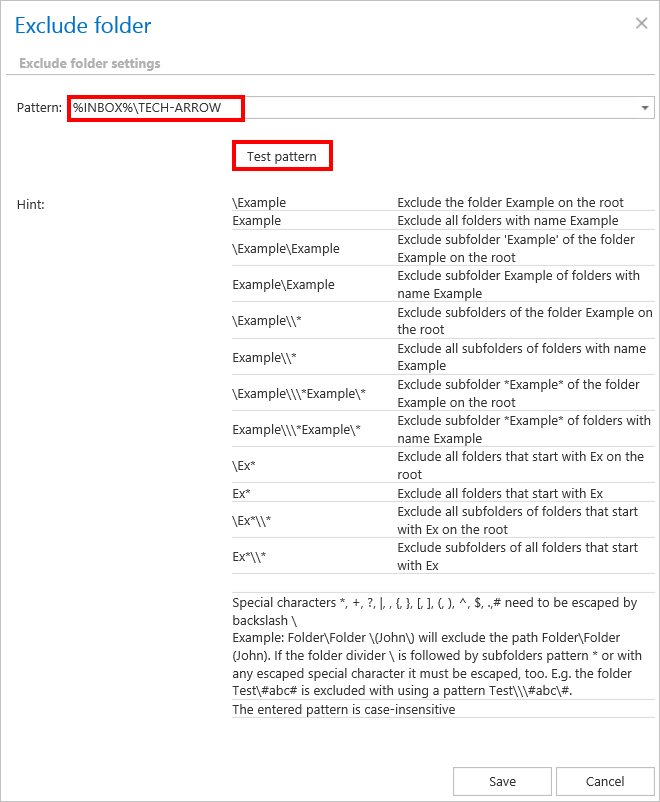
Test pattern button
This button is used to check if the entered pattern will be suitable for the path that the user would like to exclude from the archiving process. Open the Test pattern matching window by clicking on the Test pattern button. Enter the folder path into the Folder path field (this time without the % sign) and click on Test button.The test will be successful if the Pattern was entered correctly into the Exclude folder window.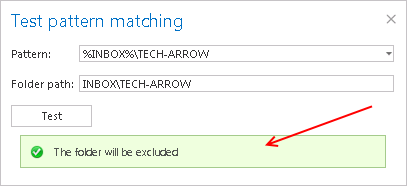
- Import the list of folders to be excluded:
The list of folders to be excluded may be imported from files in one of the available formats: CSV, XML, Tab delimited files or Space delimited file. The file to be imported must contain the list of the folders.
Important: Root folders must be specified in wildcards (%) in the import files. Subfolders must be added to a root folder with a backslash (). To import such a file with the list of folders refer to chapter Importing contentACCESS configurations from files of this guide.
Excluding folders with special characters
The folders containing special characters like brackets, hyphens, question marks, etc. can be excluded from the archiving process. To exclude such folders from the archiving process, the special characters included in the folder(s) name must be excluded using the backslash “escape character. The escape character must be added before the special character to be excluded, in the Exclude settings of the archive job’s configuration page.
E.g. you have such a structure in the mailbox: INBOXImportant (folder)
and the “Important (folder)” must be excluded (the special characters are the brackets), then you must specify the folder to be excluded like this: INBOXImportant(folder)
This information is available at the bottom of the Exclude folder window:
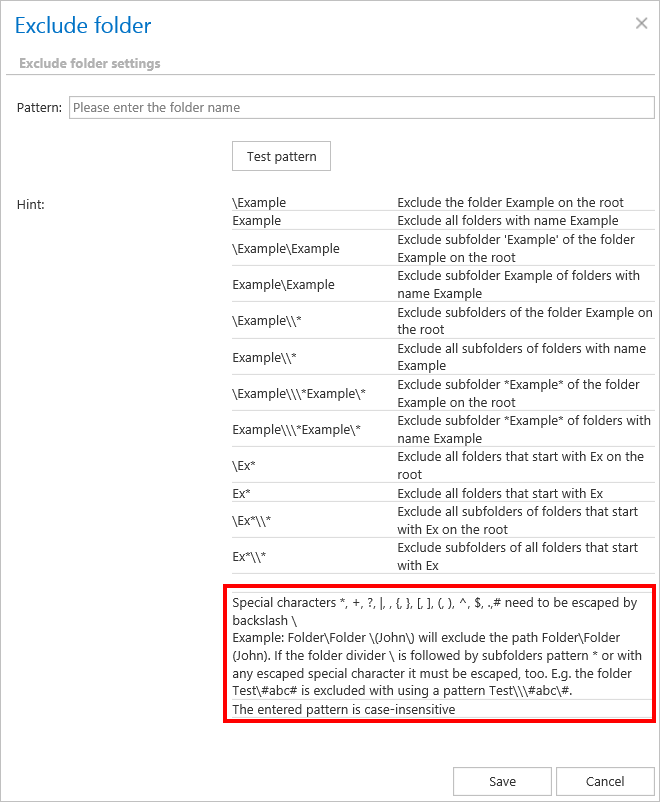
✓ Notification settings.
Select here, when you will need to get notification emails from the Email archive job. It is possible to set here if you need such a notification email always/never, or you need it only in case an error/warning occurred during the archiving process − for example, if the archiving of one or more items failed, then you may get a notification email about this error. Into the Recipient list textbox insert the email address(es) of the person(s), who will get such notifications. Notifications should be used if the administrator does not use the System logs feature.

Set the value, which will determine how many items will be processed simultaneously by the email archive job. The recommended value is “2”.

Combining the shortcutting methods in an Email archive job
What are the advantages of combining the shortcutting methods for the user?
Companies use the “Keep original” archiving method daily. This archiving method ensures that the emails and their attachments are ready at hand when they are still in use. After a certain period (usually after 6 months), it is pointless to keep these emails in the mailbox(es), as they take up too much space. However, these emails must be still easily accessible at any time. For this reason, it is recommended to replace them with shortcuts, which save space in the mailboxes and guarantee easy access to the older mailbox items. By combining the shortcut methods the end-user will easily achieve the desired result.
This use case will demonstrate how to configure an Email Archiving job, which will archive the items older than 10 days while keeping them in the original file location. The job will also replace these items with shortcuts after 6 months. The job combines the “Keep original” archiving method with the shortcutting after the item reaches a certain age (6 months in this use case). The size of the items to be archived and shortcutted can be set as well.
The following steps should be executed to set up an email archive job using the advantages of this method:
✓ Set up a new Email Archiving job and open its configuration page.
✓ Set all required sections on the job’s configuration page.
✓ On the configuration page of the Email Archiving job navigate to the “Shortcutting” section and check the “Apply to NOT ARCHIVED items” checkbox.

✓ Set the “Keep original” archive method for items that are older than 10 days. Choose the “Keep original” option from the dropdown menu and set that all items older than 10 days will be archived.

✓ Apply the shortcutting to the items archived with the “Keep original” method, which are older than 6 months and larger than 100 kB. Choose the HTML shortcut type, which will be used by the job.
Check the “Apply to ALREADY ARCHIVED items with keep original shortcutting method” checkbox. Choose the already configured “HTML” shortcut from the dropdown list. Set the sent date to 6 months and the size to “larger than 100 kB”.


✓ Save your settings and wait until the job starts to run according to the configured scheduler.


